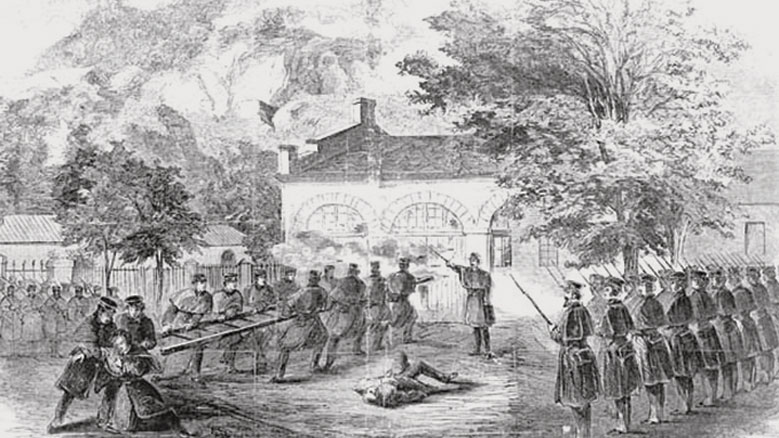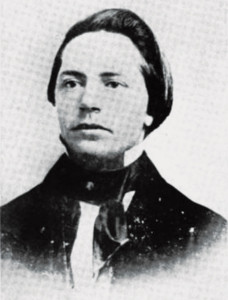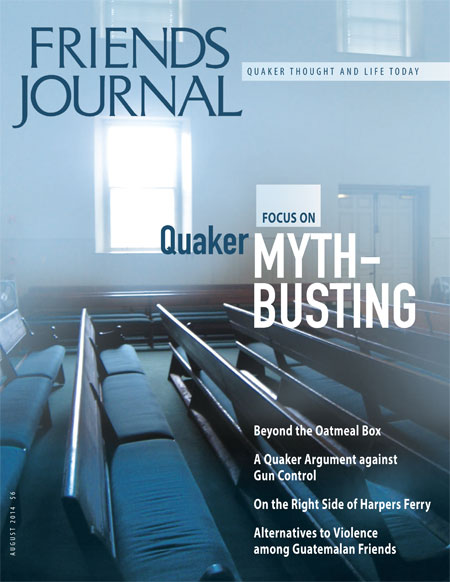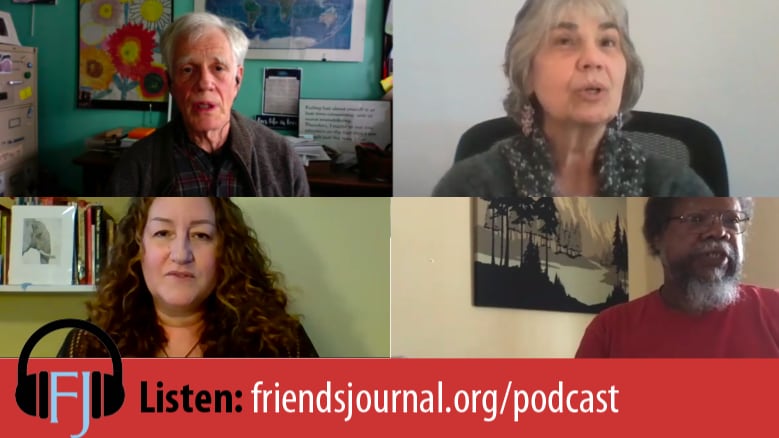
Listen to this article:
My journey began at my sister’s house for a cider-making weekend. It was their biggest cider-fest ever: 60 family and friends washing, coring, mashing, and pressing apples for over 60 gallons of cider. It was a potluck so there was plenty of food and good conversation. One conversation was with my cousin, whom I hadn’t seen in over 15 years. He stopped me short with one sentence: “We’ve confirmed that our ancestors were on the right side of Harpers Ferry.”
Until then, I hadn’t heard of this connection. Didn’t I read something about Harpers Ferry in middle school? If I recall, it had something to do with the Civil War. Did my relatives really take part in such a well-known piece of American history? On the other hand, I know a lot about my Quaker ancestry. I can tell you about my family’s journeys through the Quaker schools of Earlham College, Guilford College, Westtown School, and George School. If you mention South China, Maine, I’ll tell you about my great-grandfather’s cabin on South China Lake, near Rufus Jones’s property, or my grandfather’s missionary work in Kenya with the Five Years Meeting in the 1960s.
Upon getting home from my sister’s house, my husband pulled out his copy of John Brown, Abolitionist by David S. Reynolds. I set out to read all 506 pages. My journey also led to Ancestry.com, an online genealogy service. By using some of my brother’s family research, as well as some online information, I was able to find my link to John Brown’s raiders, Barclay and Edwin Coppoc. (Many spellings are found so I’m using Reynolds’s spelling, though my own name is passed down as Coppock.) My great-great-great-grandfather David had a brother Samuel. Edwin and Barclay were the sons of Samuel, or my three-times great-grandfather’s nephews.

In John Brown, Abolitionist, Reynolds writes of two of Brown’s volunteers: “the brothers Barclay and Edwin Coppoc were examples of that oxymoronic type, the fighting Quaker.” He explains further: “Quakers had a long history of opposition to slavery and an even longer one of pacifism. . . . The Coppoc brothers . . . had no qualms about taking up arms against slavery.” I learned more about their viewpoint: for them, slavery was a crime against God and against equality, beliefs they shared with Brown. My journey grew more complex, weighing out Quaker testimonies of pacifism against the commendable goal of abolition.
Brown was a crazed lunatic or fearless abolitionist, depending on whose work you read. In 1859, he led 21 men to a small town northwest of Washington, D.C., in Harpers Ferry, Virginia (now in West Virginia). The plan was to take over the federal arsenal, which was difficult to reach with two rivers forming a flood plain, and mountain barriers to the east. Brown believed that if he arrived with his army and freed the local slaves, he could hand them weapons and they could get to the mountains and launch a wider rebellion. The Appalachian Mountains potentially provided a mountain hideaway, as well as a path north for the slaves to escape and a path south for future abolition movements.
In Reynolds’s words, Brown held a “longstanding belief that blacks would rise up with unanimous determination if given the chance.” Brown didn’t get the uprising of liberated slaves that he thought would expand his army. Instead, he ended up trapped inside the arsenal with some of his men. During the actual raid, my ancestor Barclay was not in the arsenal but at an off-site farmhouse guarding weapons. He was one of five of Brown’s men who made it to the north and eventually back to Springdale, Iowa. He died in 1861 when, while serving as a first lieutenant Union recruiter, his train derailed in an incident called the Platte Bridge Railroad Tragedy.
Edwin, however, was at the arsenal and nearly succeeded in changing the outcome of Brown’s attack. In my research, I came across a history of Iowa (published in 1903) which revealed that the history of our nation could have been rewritten during the raid:
Few know how near the coming Southern Confederacy came to losing its greatest military leader at this moment at the hands of an Iowa boy. Edwin Coppoc saw from his port-hole the blue uniform of the commander and instantly drew a deadly bead on [Robert E.] Lee at close range. Jesse W. Graham, one of Brown’s prisoners, who was watching Coppoc, knew Lee and saw his danger. Instantly springing forward, he caught the rifle before Coppoc could fire and during the struggle Lee stepped out of range, and so lived to strike the deadliest blow against his country that it ever encountered. Had Coppoc’s bullet gone to its brilliant mark, a hundred thousand lives of American soldiers might have been spared.
Reading Reynolds’s book, I drew in my breath as I read of another of Edwin’s roles in the raid.
A railroad agent and the mayor of Harpers Ferry, [Fontaine] Beckham was beloved by both blacks and whites. Although he held slaves, he had a clause in his will liberating them upon his death. He had spent the morning in the railway ticket office, helping the wounded Shephard Hayward [an African American railway porter] and advising citizens to stay indoors until the danger had passed.
Beckham should have followed his own advice. Several times, he went out unarmed to see the state of the battle. He peeped around a water tank when Edwin Coppoc in the engine house got a bead on him with his rifle. Coppoc fired twice at Beckham. The second bullet tore through his shoulder into his upper body, killing him almost instantly.
There it was. My ancestor “drew a bead” on a townsman and killed him. Edwin was hanged two months later at the age of 24.
Some say that the raid at Harpers Ferry led directly to the election of Abraham Lincoln and was a seminal event leading to the Civil War and the beginning of the end of slavery. From here, I could go into the argument of the justified war and try to rationalize the action. People have long debated the idea of the justified war and many consider Brown and his raiders to be heroes. On the other hand, many of Brown’s early supporters “shrank back from him in horror” after the raid. A statue of Edwin stands in Salem, Ohio, where he is buried. This debate is not going to be decided here. Instead, I’m led to wonder about my own idealized view of my family’s Quaker past.
Quakers draw many tenuous lines around the testimonies, lines that often shift in response to changes in the world around us. In an increasingly electronic society, where does simplicity fit in? As for the peace testimony, I’ve heard of those who purposefully keep their income low enough that they don’t pay taxes into a defense-heavy national budget. My own Quaker father served in the U.S. Army Band during the Korean War. My Quaker father-in-law was active in the Pacific War campaigns of World War II and was serving on Oahu, Hawaii, when Pearl Harbor was attacked. All of these individuals had to draw a line around their own beliefs, set in the times they lived. The Coppoc brothers drew a line, too. I think one Friend may have summed it up most appropriately when she said they might have been on the right side of abolition but on the wrong side of Quakerism.
As skeletons in the family closet go, this story puts my ancestors in a less flattering light than I had imagined. I don’t know why I was under the false assumption that my Quaker ancestors had to be idealistic Quakers who followed the testimonies more closely than I. After all, I don’t live as simply as I could, and I’m not as good a steward of the earth as I could be. However, I can be more humble about my family’s history. When I tell you the shiny polished stories about my relatives who have attended Quaker colleges and boarding schools, had personal connections to Rufus Jones, and missionary work in Kenya, it will be along with the rusty parts brought on by the knowledge that not all of my Quaker relatives led lives in keeping with the testimonies.
References (web only):
Ancestry.com Quaker Collection: http://www.ancestry.com/cs/us/quakers
Reynolds, David S. John Brown, Abolitionist: The Man Who Killed Slavery, Sparked the Civil War, and Seeded Civil Rights, Vintage Books, 2005.
John Brown’s Raid on Harpers Ferry—The Coppoc (Coppock) Cousins strattonhouse.com/index.php?section=inn&content=john_browns_raid
Gue, Benjamin G. History of Iowa from the Earliest Times to the Beginning of the 20th Century, Chicago: Century History, 1903. (http://freepages.books.rootsweb.ancestry.com/~cooverfamily/jbrown_1903_2.html)
Link to a picture of Edwin Coppock: https://en.wikipedia.org/wiki/File:Edwin_coppock.jpg





The Coppock brothers were my 4x Great Grandfather Joshua Coppock’s Nephews. Lots of info I didn’t know. Thanks!
Eric,
I have found the Coppock brothers to be my 4x Great Grandfather Joshua Coppock’s Nephews as well! Joshua Coppock
Thomas Coppock
Logan Coppock
Walter Coppock
Joyce Coppock (Dembek) – my grandmother